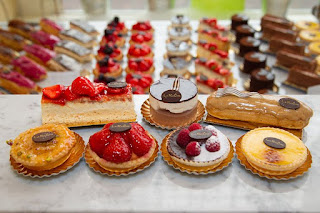To an English-speaker, a "pastry" is usually an individual-sized treat made of sweet or buttery dough, and sometimes filled with jam, chocolate, cream, etc. So a croissant, a chausson aux pommes, an éclair, or even little cakes like these are all "pastries."
 |
| C'est une friandise individuelle, avec une pâte sucrée et/ou beurrée, souvent fourrée ou couverte de crème, chocolat, confiture, etc. |
 |
| Danish pastries! |
 |
| And more pastries... |
However, these pâtisseries that are cut into pieces are more likely to be called "cake."
 |
| Pourtant, un gâteau coupé en morceaux comme ceux-ci, pour nous c'est "cake." |
What do French people mean, though, when they talk about un cake? This is a great example of a faux ami whose meaning got slightly out of sync when it snuck into the French language. LaRousse.fr defines un cake as:
Gâteau en pâte levée, garni de fruits confits et de raisins secs, moulé en rectangle.More generally, I've heard un cake used to mean any kind of sweet bread: banana bread, zucchini bread, cranberry bread, etc. In a few special cases we might also call it "cake," as with marble cake--but in French there's a (mostly) clear distinction between un cake:
("Cake made with raised dough, garnished with candied fruit and raisins, in a rectangular loaf.")
Des gâteaux:
And pâtisseries!






No comments:
Post a Comment